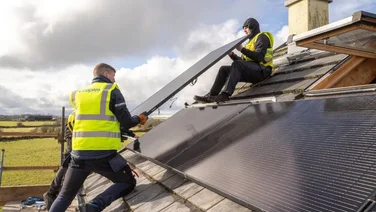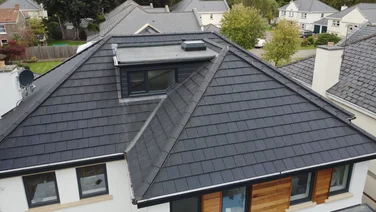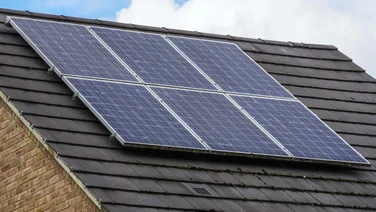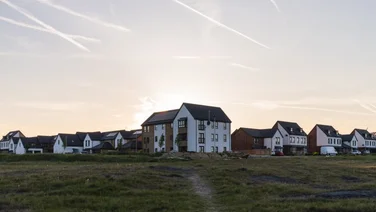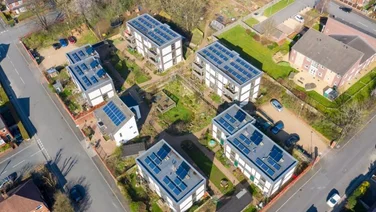- What’s on this page?
- Can you have solar panels on a flat roof?
- Advantages and disadvantages of flat roof solar panels
- What’s the optimum angle for flat roof solar panels?
- Do you need planning permission for flat roof solar panels?
- Things to consider before installing flat roof solar panels
- FAQs
- Next steps
✔ Solar panels can function on flat roofs…
✔ …But they’re more susceptible to water damage
✔ Panels will need to be mounted at a 20-50 degree angle to be effective
If you have a flat roof, you may be wondering if it’s worth paying the cost of solar panels. Thankfully, they’re suitable for most properties – even ones with flat roofs.
But if you have a flat-roofed property and fancy getting yourself some panels, you’ll need to know which extra equipment to get, how to look after your panels properly, and how to avoid damage. Luckily, we’ll tell you everything you need to know further down the page.
If you’re already set on getting a solar panel system for your home, we can speed up the process for you. Rather than scouring the internet for the best companies and prices, simply answer a few short questions on this form.
We’ll pass your details on to our trusted suppliers, who will then get in touch with free quotes for you to compare, so you can cut your energy bills during this cost of living crisis.
Where do you want to install solar panels?
Get startedWhat’s on this page?
Can you have solar panels on a flat roof?
Solar panels work very effectively on flat roofs, but you’ll need to make sure that you install them with the right mounting equipment to make the system efficient.
Although flat roof solar panel systems are more commonly found on commercial buildings, they also work well on domestic properties.
That means you can still harness clean energy and reduce your energy bills with solar panels, even if you have a flat roof.
You can also put solar panels on the wall of your property, although this is usually best when done alongside roof-mounted solar panels.
And if you don’t have enough room on your roof, why not look into installing solar panels on your garage roof?
How do they work?
The solar panels that are used on a flat roof are exactly the same as the ones used on a pitched roof. You can technically lay the panels down on a flat roof – just as you would on a pitched roof – but this will restrict them from absorbing as much sun as possible, and might also lead to water damage.
That’s why you need to install a framing system, to tilt your panels towards the sun. This will help them self-clean in the rain, and avoid damage from pooling water.
There are two main options when it comes to framing systems for solar panels on a flat roof – fixing the mounting equipment to the roof or using a weighted tub/bucket:
- Fixing panels to your home – This involves drilling into the roof itself and securing the brackets to keep the mounting frame stable. Take extra care to ensure the roof remains watertight
- Adding weight – If you’re unable to penetrate your roof, a good alternative is to simply add weight to the structure. The mounting frame can slot into concrete ballasts (heavy slabs) and make the panels much more wind-resistant. Alternatively, the panels can be fixed to specialised tubs, which are weighed down with slabs

Where do you want to install solar panels?
Get startedHow big is your solar panel system, and how roughly much did it cost?
“We have a 5.76 kilowatt (kW) system, comprising of 16 360 watt (W) fully black Canadian solar panels. They’re connected to a Solis 5G 5.0 kW dual tracker inverter, with direct current (DC) isolation […].“We paid just under £5,000 for the whole system, and £750 for an electric car charging port.”
Do your solar panels generate enough power to cover all your electricity needs?
“I would say that they cover half of our electricity needs, or up to two thirds. Obviously when there is more sun, we are better off.“We have a smart meter, and I see it set to zero a lot of the time.”
Are you receiving money via the Smart Export Guarantee?
“We are with Octopus Energy, and I think we get 9p per kilowatt hour. We signed up for the Smart Export Guarantee when we signed up with Octopus.”
Melissa lives in the East Midlands, and has owned solar panels since July 2022.
Advantages and disadvantages of flat roof solar panels
Getting solar panels for any property comes with its pros and cons, but with a flat roof, you have a few extra things to think about.
Advantages of flat roof solar panels
- Easy access for installation and maintenance – Having solar panels on a flat roof means that installers can easily access the system for any maintenance, unlike on a sloped roof, which can be dangerous and difficult to clamber on
- Panels probably won’t be visible from the street – You won’t need to worry about the aesthetics of solar panels (if that’s something you’re concerned about) with a flat roof. Pedestrians and fellow neighbours will be none the wiser
- You’ll be able to save money on electricity bills –Solar panels can cut the average user’s electricity bill by 70%, leading to savings between £272 and £636 per year for most homes. Find out more on our Solar Panel Costs page
- You’ll be able to shrink your carbon footprint – According to the Energy Saving Trust, a typical solar PV system could reduce your carbon footprint by around one tonne of carbon per year, depending on your location
- They’re low maintenance – Want to keep your solar panels ticking along nicely? The main thing you need to do is keep them clean, which only usually needs to be done twice a decade. Find out more on our Solar Panel Repairs and Maintenance page
- Labour costs can be more affordable – If you’ve got a flat roof, the installers should have easier access to the site and might not need to put up any scaffolding. This will reduce labour costs massively
Disadvantages of flat roof solar panels
While there are a number of disadvantages to flat roof solar panels, bear in mind that most of these can be resolved by using a tilted mounting system.
- Panels get far dirtier over time – On a tilted roof, rainwater usually washes dirt and debris off the panels. Without this self-cleaning feature, the dirt will stay there, reducing the solar panel’s efficiency
- Without additional mounting equipment, panels won’t get as much exposure – Solar panels usually face southward on a tilted roof, in order to increase sun exposure and create more energy. Laid flat, panels are unable to convert as much energy because they will not be getting as much sunlight
- Flat roof panels can make some warranties ineffective – When panels are laid flat, water sits between the frame and the glass coating of the module. Given this gap is only sealed with silicon, which easily degrades over time, panels are likely to become damaged faster than usual
- Wind effects are greater, which means your installer will need to be careful while designing the mounting system. Sometimes ballast weight is required, so you’ll need a structural engineer to check the roof can hold this extra weight.
On top of this, installation can come with a few added costs. To avoid the disadvantages above, many people invest in mounting systems. Generally, solar panel racking should make up roughly 3% of the total system cost, although this will fluctuate depending on the brand and type of rack you get, along with the amount you need to buy.
What’s the optimum angle for flat roof solar panels?
To avoid water damage, it’s wise to invest in a mounting system that props your panels up. Roofs come in all shapes and sizes but, generally, panels will need to be mounted at a 20-50 degree angle to absorb as much sunlight as possible.
And, as an added bonus, panels at this angle have a better chance of staying clean, as rainfall will remove debris and dirt that could reduce the panel’s efficiency.
Remember that solar panels weigh quite a lot, so you’ll need to make sure they’re secured onto any mounting equipment properly.
Installers will often use specialist equipment to mount panels at the perfect angle, so make sure you contact a qualified professional to carry out your installation.
Want to find trusted installers now? Get a head start by filling out this short form – after answering a few questions about your property, our professional suppliers will be in touch with free quotes for you to compare.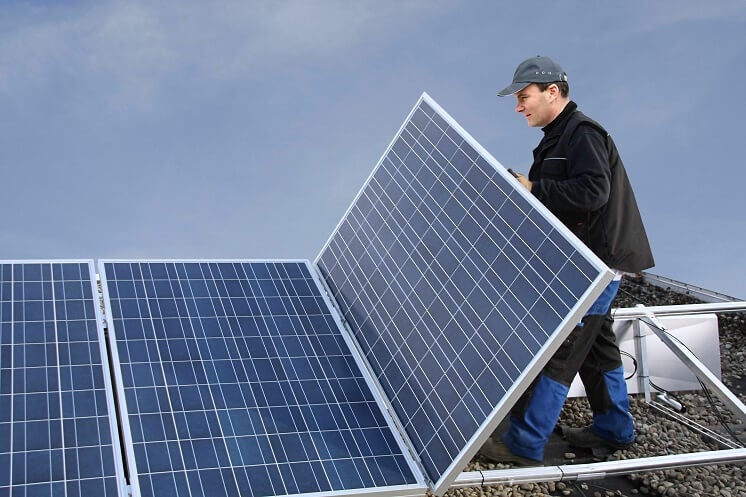
Do you need planning permission for flat roof solar panels?
You usually need planning permission to install flat roof solar panels.
Solar panels on pitched or tilted house roofs rarely require planning permission because they fall under the ‘permitted development’ category – but that’s not the case with flat roof solar panels.
Since they aren’t classified as permitted developments, planning permission is more likely to be required.
It’s therefore a good idea to check with The Planning Portal – the national planning application service for England and Wales.
Things to consider before installing flat roof solar panels
Do you have the right weather conditions?
Weather is an important thing to consider when it comes to solar panels – especially if they’re sitting on a flat roof.
We’ve already mentioned how rain can damage panels on a flat roof, with water pooling causing the silicon to degrade, but thankfully this can be easily resolved with a mounting rack. High winds, however, can be a bit more tricky to deal with.
If you live in a particularly windy area, it’s a good idea to take a few extra precautions to keep your panels pinned down. The most popular way of doing this is either by fixing the panels to the house, or adding weight to them.
How much does it cost to install solar panels on a flat roof?
Generally, installing solar panels on a flat roof will cost more than on a pitched roof – around 20% more, depending on the situation.
Of course, prices vary depending on a range of factors, including the number of panels you get and which mounting technique you use.
The key reason flat roof solar panel installations are more expensive is the extra cost of materials for the framing system and ballast weight. You’ll also usually need to hire a structural engineer, which adds to the cost.
How much money could you save with solar?
The average three-bedroom house will save £454 per year with a 3.5 kWp solar PV system.
Our research into whether solar panels are worth it also shows that if you installed solar panels today, you’d break even in 15.66 years, and make an overall profit of £4,335 after 25 years.
And with 65% of people telling our latest National Home Energy Survey that they’d buy a house with solar panels, there’s every reason to go green.
FAQs
Are solar panels effective on a flat roof?
Solar panels can still be effective on a flat roof – providing they’re angled in the right position, facing the right direction, and don’t have any objects blocking the sun from them. If you’re located in the UK, your mounting system will need to position your panels at a 20-50 degree angle to make sure they effective, and will need to be facing southwards.
Can you also have solar thermal systems on a flat roof?
Yes, you can keep your home warm during the chillier months by installing solar thermal systems on a flat roof. Similar to regular photovoltaic (PV) systems, solar thermal panels can be attached to a flat roof with a mounting rack.
Do I need planning permission for solar panels on a flat roof?
You shouldn’t need planning permission when installing solar panels onto your properties, whether you have a flat or a pitched roof – unless you live in a conservation area or listed building. If this is the case, it’s a good idea to check with your Local Planning Authority before investing in a set of solar panels.
Will solar panels impact my roof’s warranty?
Most warranties allow homeowners to install solar panels onto their flat roofs. However, we still recommend that you get in touch with your warranty provider before you crack on with the installation, in case they have some terms and conditions you should be aware of.
Next steps
Domestic renewable energy is becoming increasingly common across the UK, and as one of the most space-efficient ways to harness green energy, solar is leading the way. Plus, as we’ve discovered in this article, having a flat roof doesn’t have to be a barrier to installing solar panels at home.
So, if you’d like to join the UK’s growing list of solar-powered homes, it’s time to start hunting for the perfect set of panels.
Luckily, we can help with that – all you have to do is pop your details in this quick form. Once we’ve got your information, we’ll pass it on to our trusted suppliers, who will then be in touch with free quotes for you to compare.
You’ll be on your way to smaller bills and an even smaller carbon footprint in no time!


